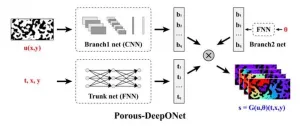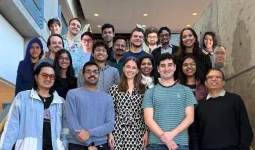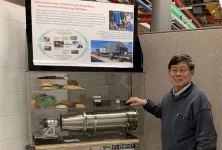(Press-News.org) Porous media play a critical role in various industrial fields due to their complex pore networks and considerable specific surface areas. The transport and reaction phenomena within porous media are key factors influencing fundamental parameters such as energy storage efficiency, catalytic performance, and adsorption rates. To accurately describe these complex transport and reaction processes, solving parameterized partial differential equations (PDEs) is necessary. However, due to the complex structure of porous media, traditional methods, such as the finite element method (FEM), require substantial computational resources. There is an urgent need for innovative methods to accelerate the solution of parameterized PDEs in porous media. Researchers have developed a novel deep operator network, Porous-DeepONet, which can efficiently capture the complex features of porous media and thereby more precisely and effectively learn the solution operators, providing a robust alternative for solving parameterized reaction-transport equations in porous media and paving the way for exploring complex phenomena within them.
Deep operator networks (DeepONet) are a popular deep learning framework often used to solve parameterized PDEs. However, applying DeepONet to porous media presents significant challenges due to its limited ability to extract representative features from complex structures. To address this issue, researchers proposed Porous-DeepONet, a simple yet efficient extension of the DeepONet framework that utilizes convolutional neural networks (CNNs) to learn the solution operators of parameterized reaction-transport equations in porous media. By incorporating CNNs, Porous-DeepONet can effectively capture the complex features of porous media, achieving accurate and efficient learning of the solution operators. Additionally, researchers have coupled Porous-DeepONet with other DeepONet frameworks to extend its applicability to solving multiphysics coupled equations in porous media, resulting in Porous-DeepM&Mnet and Porous-PI-DeepONet, which are based on physical information.
To validate the effectiveness of Porous-DeepONet in accurately and rapidly learning the solution operators of parameterized reaction-transport equations under various boundary conditions, multiphase, and multiphysics fields, researchers conducted a series of comprehensive numerical simulations. The results demonstrate that Porous-DeepONet has the capability to accurately capture system behavior under various challenging conditions, showcasing its practical application potential for simulating complex porous media with different reaction parameters and boundary conditions. Compared to traditional FEM methods, Porous-DeepONet is three orders of magnitude faster in solving the same problems. Furthermore, when Porous-DeepM&Mnet is used to solve the Poisson–Nernst–Planck (PNP) equations, the solution speed is improved by approximately 50 times. Porous-DeepONet has thus become a powerful tool for addressing the solution of parameterized PDEs in porous media, especially excelling in handling complex domain geometries and multiphysics coupled equations. This research provides strong support for further exploration and application in related fields.
In summary, this work introduces Porous-DeepONet, a deep learning framework designed to learn solution operators for parameterized PDEs in porous media, with a focus on reaction-transport equations. Compared to traditional FEM, this extension can significantly improve solving efficiency. To assess the accuracy and applicability of Porous-DeepONet, researchers solved various reaction-transport equations, including the Fick diffusion equation, Fick diffusion and surface reaction equations, advection equations, and heat conduction equations. The results indicate that Porous-DeepONet efficiently solves single-phase and multiphase parameterized PDEs with complex boundary conditions, with computation times three orders of magnitude faster than traditional FEMs. Additionally, by combining Porous-DeepONet with DeepM&Mnet to address the challenge of solving multiphysics coupled PNP equations, computation times were dramatically reduced by a factor of 50. With improvements and optimizations, Porous-DeepONet has become a powerful tool for solving parameterized PDEs in porous media, particularly excelling in handling complex domain geometries and multiphysics coupled equations. This research provides strong support for further exploration and application in related fields.
The paper “Porous-DeepONet: Learning the Solution Operators of Parametric Reactive Transport Equations in Porous Media,” authored by Pan Huang, Yifei Leng, Cheng Lian, Honglai Liu. Full text of the open access paper: https://doi.org/10.1016/j.eng.2024.07.002. For more information about the Engineering, follow us on X (https://twitter.com/EngineeringJrnl) & like us on Facebook (https://www.facebook.com/EngineeringJrnl).
END
Porous-DeepONet: A deep learning framework for efficiently solving reaction-transport equations in porous media
2024-08-20
ELSE PRESS RELEASES FROM THIS DATE:
Association for Molecular Pathology files lawsuit against FDA to challenge final rule on regulation for laboratory developed testing procedures
2024-08-20
ROCKVILLE, Md. – August 19, 2024 – The Association for Molecular Pathology (AMP), the premier global molecular diagnostic professional society, and world-renowned pathologist Michael Laposata, MD, PhD, today announced the filing of a lawsuit challenging the recent U.S. Food and Drug Administration (FDA) Rule that regulates laboratory developed test (LDT) procedures as medical devices under the Federal Food, Drug, and Cosmetic Act. The lawsuit was filed in the U.S. District Court for the Southern District of Texas against the FDA; Robert M. Califf, MD, in his official capacity as Commissioner of Food and Drugs; the U.S. Department of Health ...
Using AI to find the polymers of the future
2024-08-20
Nylon, Teflon, Kevlar. These are just a few familiar polymers — large-molecule chemical compounds — that have changed the world. From Teflon-coated frying pans to 3D printing, polymers are vital to creating the systems that make the world function better.
Finding the next groundbreaking polymer is always a challenge, but now Georgia Tech researchers are using artificial intelligence (AI) to shape and transform the future of the field. Rampi Ramprasad’s group develops and adapts ...
Salk Professor Rusty Gage awarded 2024 Taylor International Prize in Medicine
2024-08-20
LA JOLLA (August 14, 2024)—Professor Rusty Gage has been awarded the 2024 J. Allyn Taylor International Prize in Medicine by the Schulich School of Medicine & Dentistry and the Robarts Research Institute at Western University. One of the most prestigious medical research awards in Canada, the Taylor Prize recognizes scientists for transformative, career-defining work in basic sciences, translational research, and medical innovations.
This year’s prize specifically honors a research leader in aging-related medical science and research—a long-term focus of Gage and his lab. Gage will receive $50,000 and be celebrated at a Robarts Research ...
Heart data unlocks sleep secrets
2024-08-20
We know that quality sleep is as essential to survival as food and water. Yet, despite spending a third of our lives in slumber, it largely remains a scientific mystery.
Not that experts haven’t tried.
Sleep analysis, also known as polysomnography, is used to diagnose sleep disorders by recording multiple types of data, including brain (electroencephalogram or EEG) and heart (electrocardiogram or ECG). Typically, patients are hooked up to dozens of sensors and wires in a clinic, tracking brain, ...
Development of a model capable of predicting the cycle lives of high-energy-density lithium-metal batteries
2024-08-20
1. NIMS and SoftBank Corp. have jointly developed a model capable of predicting the cycle lives of high-energy-density lithium-metal batteries by applying machine learning methods to battery performance data. The model proved able to accurately estimate batteries’ longevity by analyzing their charge, discharge and voltage relaxation process data without relying on any assumption about specific battery degradation mechanisms. The technique is expected to be useful in improving the safety and reliability of devices powered by lithium-metal batteries.
2. Lithium-metal ...
UVA Engineering Professor’s $600,000 grant set to innovate pediatric brain tumor treatment
2024-08-19
Natasha Sheybani, assistant professor of biomedical engineering at the University of Virginia School of Engineering, will collaborate with researchers at Children’s National Hospital to study the combination of two therapies for pediatric brain cancer.
High-risk brain tumors in children often don’t respond well to existing chemotherapy and radiation treatments, but Sheybani and her collaborators hope their fusion of therapies will offer a better option.
Over the two-year project, researchers ...
Illinois researchers develop index to quantify circular bioeconomy
2024-08-19
URBANA, Ill. – As the world faces the challenges of mitigating climate change and providing resources for a growing population, there is increasing focus on developing circular economies for sustainable production. But to evaluate strategies and impacts, it is necessary to have reliable metrics. Researchers at the University of Illinois Urbana-Champaign have developed a Circularity Index that provides a comprehensive method to quantify circularity in bioeconomic systems. In a new paper, they outline the method and apply it to two case studies – a corn/soybean farming operation and the entire U.S. food and agriculture system.
“The ...
Less severe forest fires can reduce intensity of future blazes
2024-08-19
Not all forest fires have devastating effects. Low- and moderate-severity forest wildfires can reduce the intensity of future conflagrations for as long as 20 years in certain climates, according to new research by the University of California, Davis.
The extent of reduced severity of these second fires, or reburns, and the duration of the moderating effect, varies by climate, forest type and other factors. But initial fires continue to mitigate future severity even during extreme weather, such as wind, high temperatures and drought, research published in the journal Ecological ...
Electric reactor could cut industrial emissions
2024-08-19
Currently, industrial processes in the U.S. account for approximately a third of the country’s carbon dioxide emissions – even more than the annual emissions from passenger vehicles, trucks, and airplanes combined. Decarbonizing this sector is a challenging but vital step in mitigating impacts on our future climate.
Researchers at Stanford Engineering have designed and demonstrated a new type of thermochemical reactor that is capable of generating the immense amounts of heat required for many industrial processes using electricity instead of burning fossil fuels. The design, published Aug. ...
Causal relationship between PECAM-1 level and cardiovascular diseases
2024-08-19
https://www.scienceopen.com/hosted-document?doi=10.15212/CVIA.2024.0032
Announcing a new article publication for Cardiovascular Innovations and Applications journal. Platelet endothelial cell adhesion molecule (PECAM-1) is present in the vascular endothelium and plays important roles in various biological processes. Several recent studies have reported associations between PECAM-1 and certain subtypes of cardiovascular diseases (CVDs). However, further research is necessary to clarify the causal effects of PECAM-1 on CVDs.
To determine whether PECAM-1 and CVDs are causally ...








